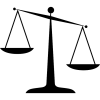How heavy can a graviton be?
2022.04.07 12:52 - Marek PawłowskiScientists are trying to determine the properties of the graviton – the hypothetical particle that carries the gravitational force. In a study published in the Journal of High Energy Astrophysics, based on the analysis of 12 galaxy clusters, prof. Marek Biesiada and his colleagues presented a new limit on the mass of graviton. It is seven orders of magnitude stronger than the limitations of observing gravitational waves.
The general theory of relativity (or general relativity for short) has changed our ideas about gravity. According to the general relativity, matter bends space-time, and all objects, if not influenced by other, non-gravitational interactions, move in this curved space-time along special trajectories called geodetic. For not very large curvatures of space-time and low velocities, compared to the speed of light, Einstein’s theory recreates Newton’s law of universal gravitation, which we still successfully apply to describe the motion of planets or stars in galaxies.
We know that the other three fundamental forces – the long-range electromagnetic force, and the weak and strong forces that govern matter at the subatomic level – are quantum in nature. In the quantum description, the interaction consists in the exchange of the particle (boson) that carries them. For electromagnetism it is a photon – a light particle, a quantum of an electromagnetic wave. For strong and weak interactions, these are gluons and the Z and W bosons, respectively. For over a hundred years, physicists have been trying to look at universal gravity in the same way, looking for the quantum theory of gravity. By analogy to other interactions, the hypothetical particle carrying gravity would be the so-called graviton. Due to the infinite range of gravitational interactions decreasing with the square of the distance, a graviton – like a photon – should be massless.
When examining the properties of a hypothetical graviton, the opposite question can be posed: what observable consequences should appear in the available picture of the universe and its dynamics, if the graviton had different characteristics than we expect – for example, if it had a very small, but non-zero mass? If the observational data – always burdened with uncertainty – are consistent with the massless graviton hypothesis, then the uncertainty related to these data allows for the estimation of the maximum mass of a graviton in advance, i. e. it allows to answer the question of how light a graviton can be, so that the consequences resulting from its mass do not conflict with still the observational data. In a study published in the Journal of High Energy Astrophysics, prof. Marek Biesiada from NCBJ together with PhD. Aleksandra Piórkowska-Kurpas from the University of Silesia and prof. Shuo Cao from Beijing Normal University thus obtained a limit on the mass of graviton mg < 5·10–29 eV.
„Each particle has a characteristic length of the so-called Compton wave – inversely proportional to its mass”– explains prof. Marek Biesiada. ” The greater the mass, the shorter the wavelength. In the case of interaction-carrying particles, the Compton wavelength determines the extent of the interaction. Zero mass means infinite Compton wavelength, or infinite range. In the case of electromagnetism, the theory predicts that the photon should be massless. It’s the same with gravity. Thus, studies of the graviton’s mass are, in fact, a test of the theory. They are a very important test, because some researchers have proposed theories modifying the general relativity, which predict that the range of the gravitational interaction should be finite. In theories of such modifications, the Newtonian potential is subject to: at long distances, the force of gravitational attraction decreases faster than with the square of the distance. „
Currently, we have more and more accurate measurements of the masses of galaxy clusters as a function of distance from the center. This is possible thanks to a combination of X-ray observations and cosmological microwave radiation recorded by the Planck satellite.
„In our research, we used mass measurements of 12 galaxy clusters from the X-COP sample, testing possible deviations from the Newtonian potential” – adds professor Biesiada. „As a result, we obtained one of the strongest upper bounds on the mass of a graviton. It is seven orders of magnitude (10 million times) stronger than the limit provided by the observation of gravitational waves by LIGO-Virgo detectors. „
NCBJ scientists participate in all ongoing and planned projects of key importance to cosmology. They will surely bring new and more accurate tests of fundamental physics.
Original work: Graviton mass from X-COP galaxy clusters; Aleksandra Piórkowska-Kurpas, Shuo Cao, Marek Biesiada; Journal of High Energy Astrophysics Volume 33, March 2022, Pages 37–43;https: 37–43//doi. org/10.1016/j. jheap. 2022.01.001

















